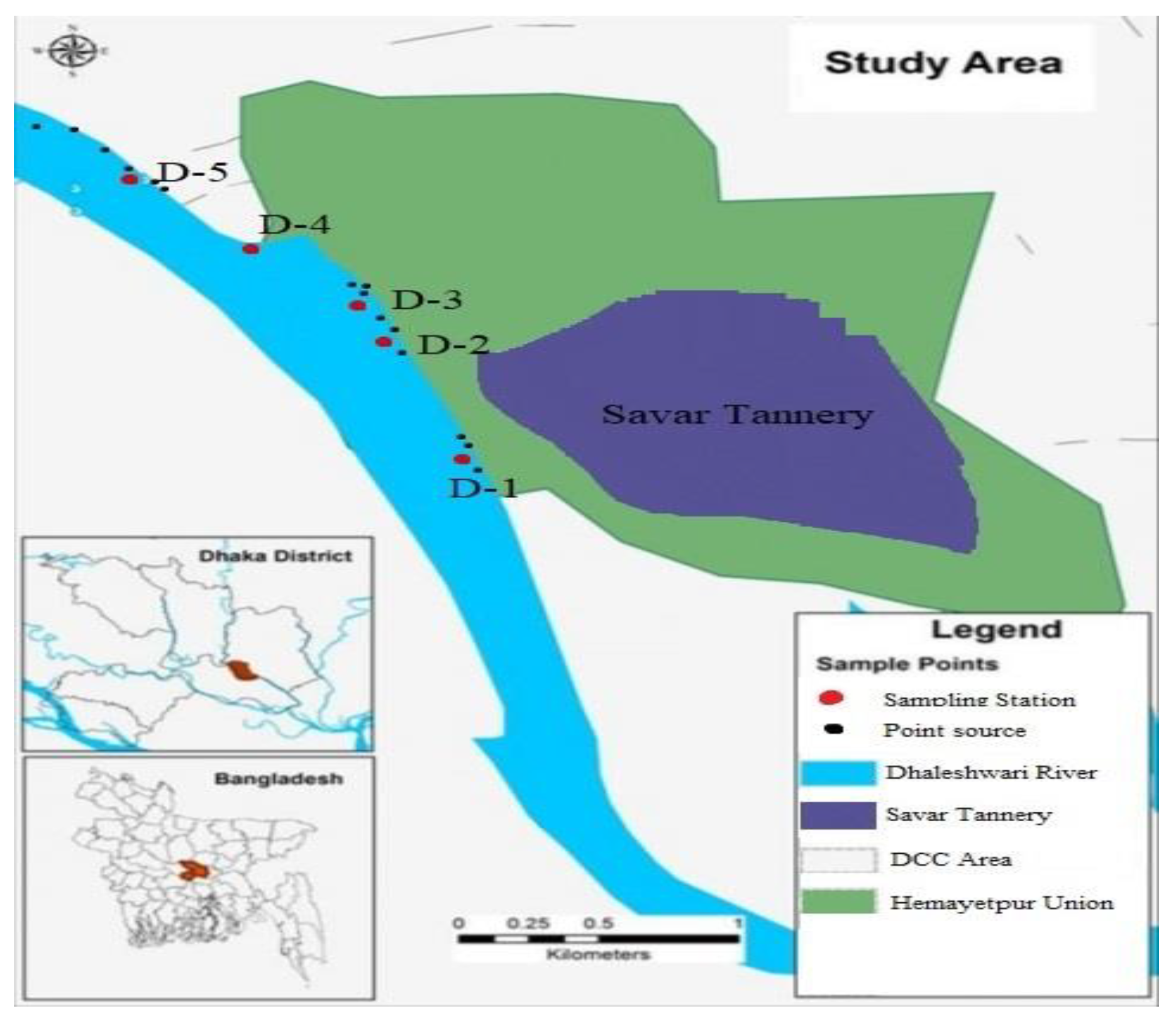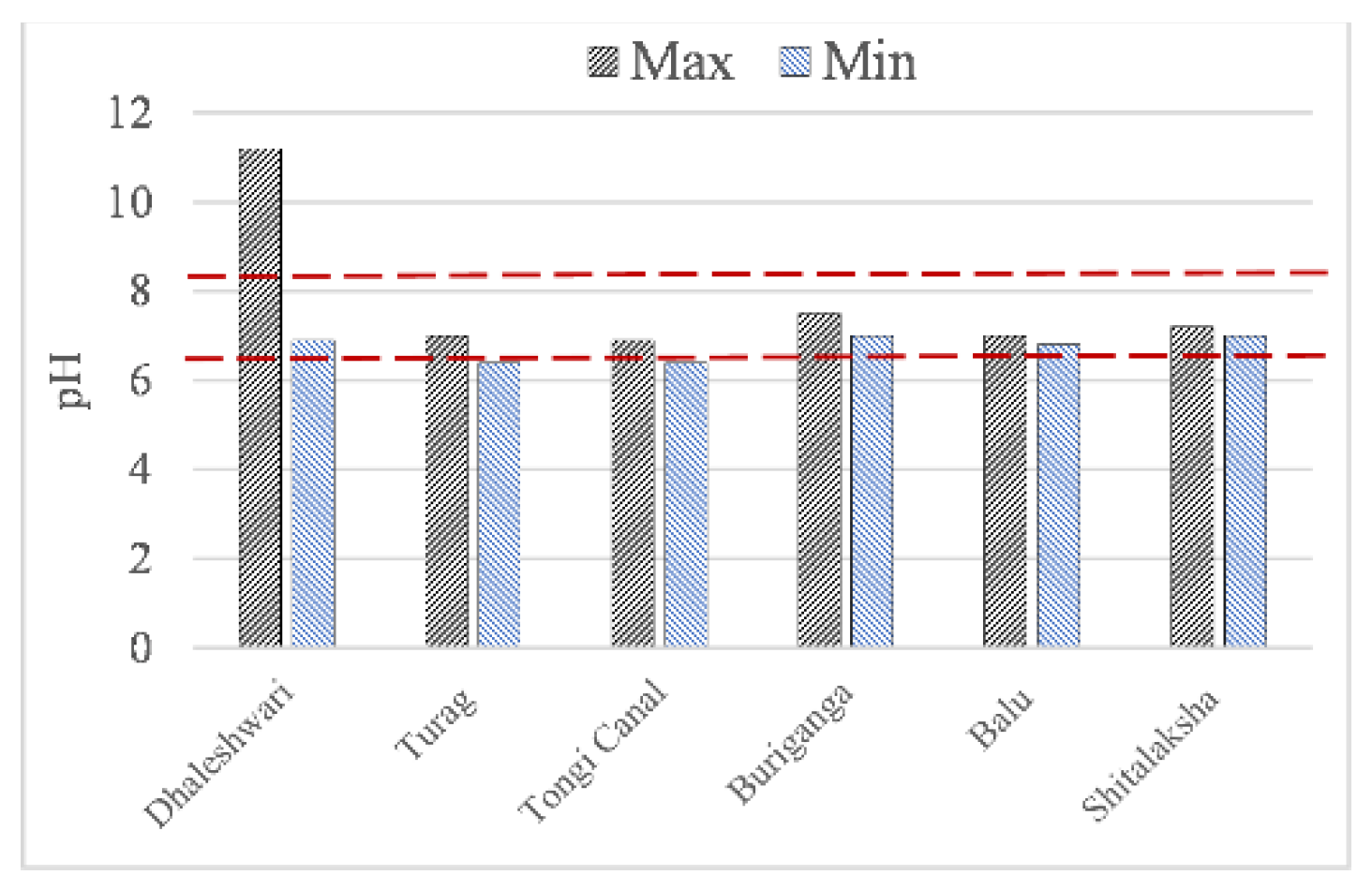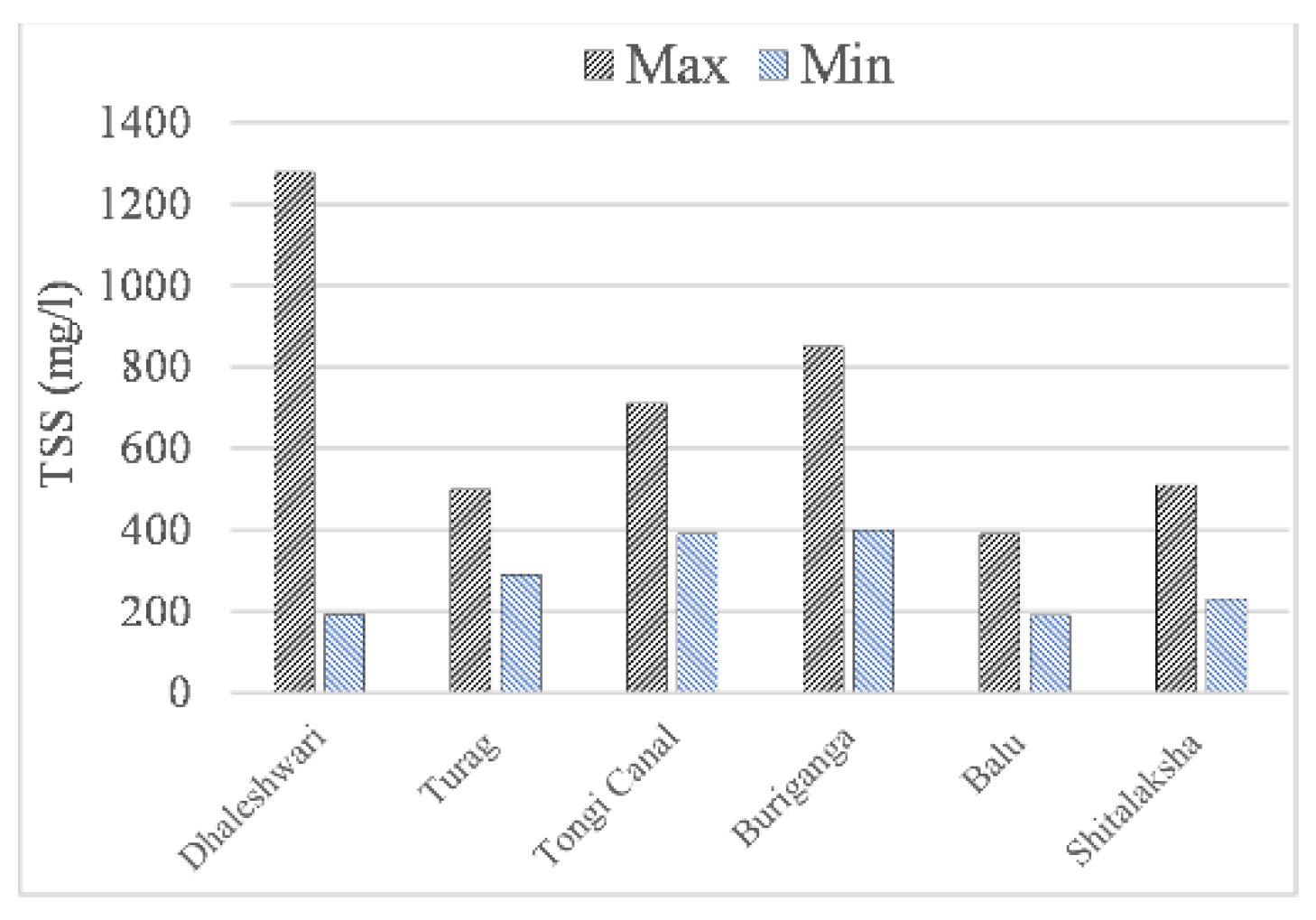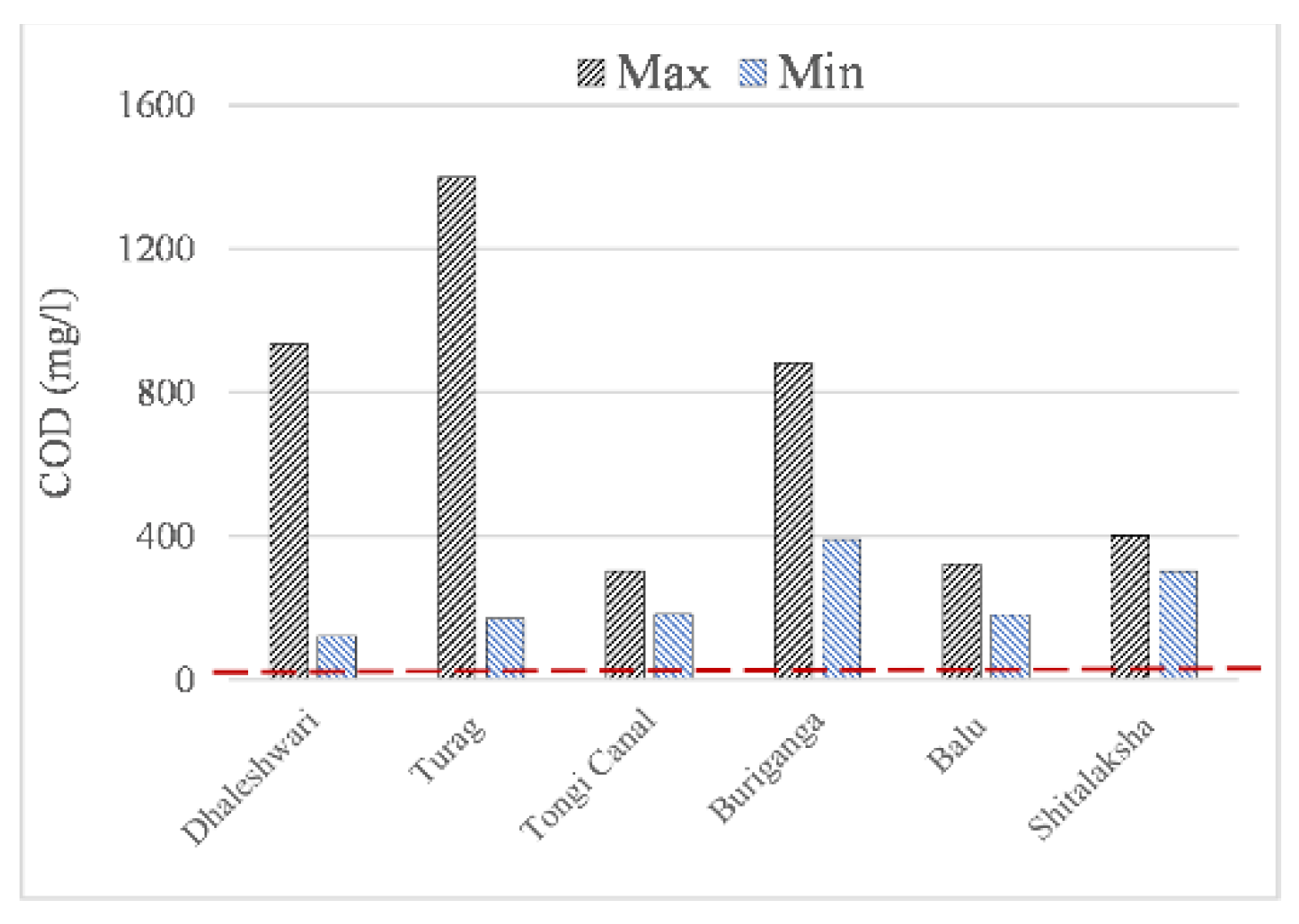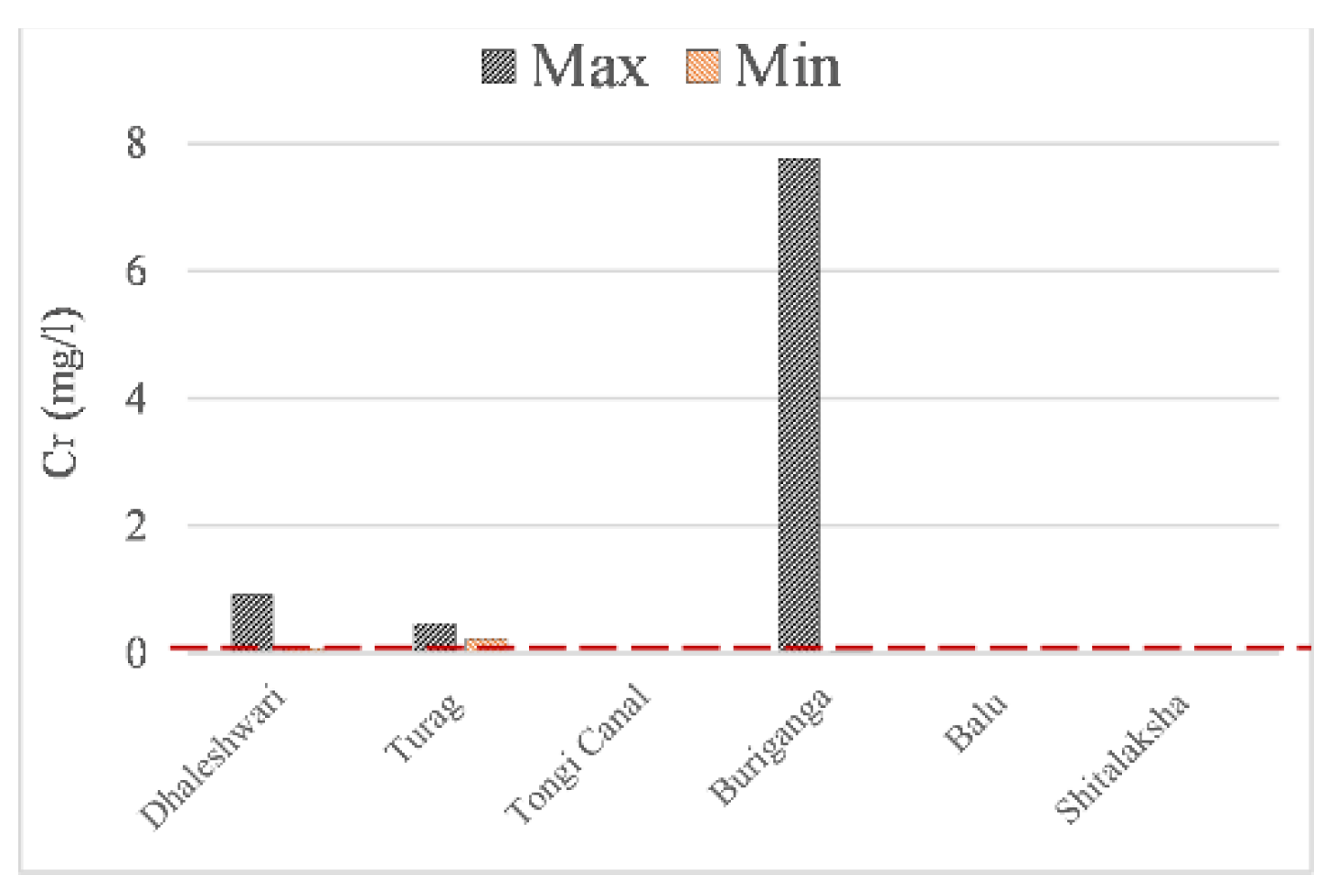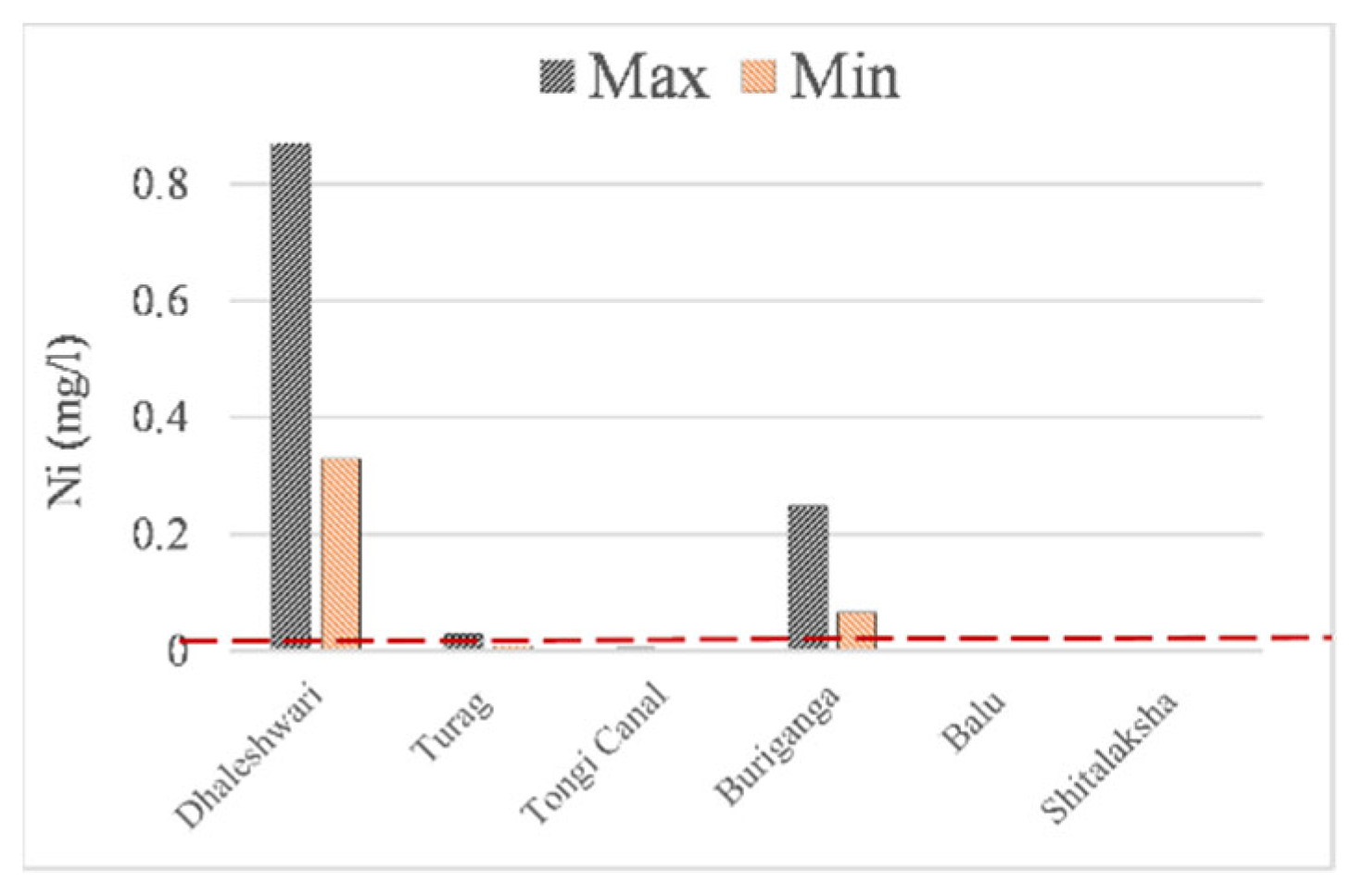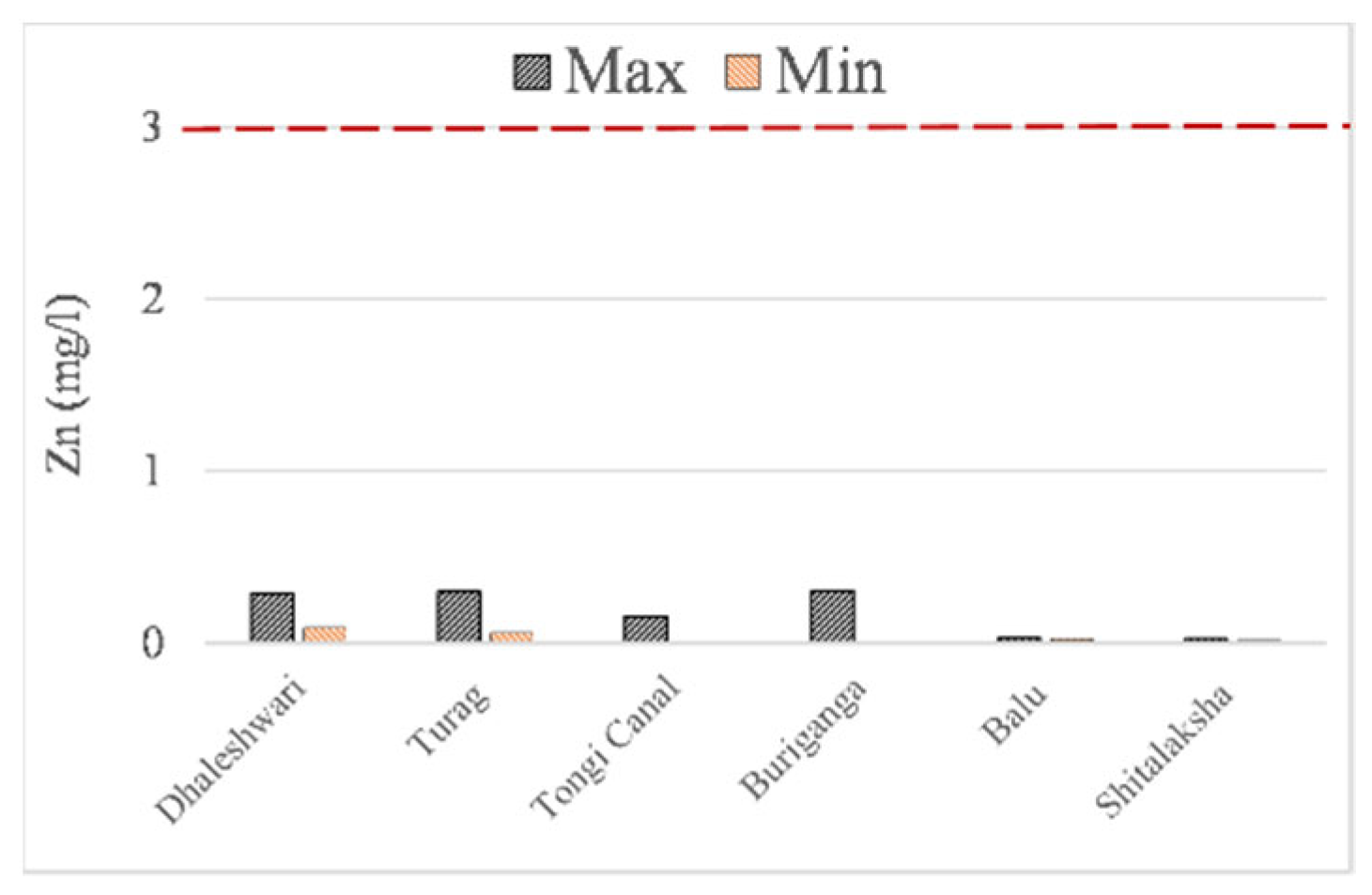3.1. Assessment of Physicochemical Parameters of Surface Water
Surface water sampled from all the rivers in Dhaka City were analyzed for various water quality indicators.
Table 3 summarizes the results on the assessment of physicochemical characterization of the peripheral rivers around Dhaka City along with the water quality guidelines established by the WHO and Environmental Conservation Rule (ECR). Average values of all the parameters that were obtained from sampling at multiple locations have been presented in
Table 3 that provides a comparative scenario in a snapshot. The Dhaleshwari River water was dark in color and had an acrid odor during the period of the study. The pH value varied from 6.9 to 11.2, along with the sampling locations of the river. The maximum pH value was observed at Sampling station D-1 (Savar Tannery), and the minimum pH value was recorded at Sampling station D-3 (Dhalla, fish market).
Figure 3 and
Figure 4 represent Max
m Vs Min
m concentrations of pH and TDS, respectively for the peripheral rivers of Dhaka, along with the WHO standards in dotted lines. The pH value was within the standard limit in the study, as assessed for the other peripheral rivers in Dhaka City. Total dissolved solids (TDS) primarily represents the different types of minerals, alkalis, some colloidal and dissolved solids in water, some acids, sulfates, metallic ions, etc., [
52]. TDS in the water of the Dhaleshwari River ranged from 412 to 3278 mg/L with the maximum level of TDS obtained at sampling station D-1 (Savar Tannery) and the minimum level at sampling station D-5 (Nama Bazar) (
Figure 4). Except for Savar tannery (D-1) and Sudkhira (D-2), all sampling stations exhibited values below the permitted level of WHO guidelines (1000 mg/L) for Dhaleshwari River. The water becomes more turbid and saltier when the TDS level exceeds the allowable limit of 1000 mg/L, which has a negative impact on aquatic life [
57,
58]. Consequently, it has an ultimate effect on the human, crop, and livestock. During the monsoon season, runoff water flow may cause some variance, but this volatility has impacted the irrigation system. Effluents from dyeing units might potentially be a contributing factor to the elevated TDS levels reported in other areas with dyeing facilities [
59]. For the other peripheral rivers, TDS concentration was obtained within the permissible limit except for the Shitalakshya River (1200 mg/L) (
Figure 4).
Figure 5 and
Figure 6 represent Max
m vs. Min
m Concentrations of BOD
5 and DO for all the peripheral rivers of Dhaka, respectively, with WHO standards in dotted lines. Testing of BOD
5 is the best single test for evaluating organic contamination and has significant relevance in water quality evaluation [
60]. The BOD
5 ranged from 11 to 45 mg/L for the Dhaleshwari River samples, showing that the water is extremely contaminated (
Figure 5). The observed BOD
5 levels in the water samples indicated organic waste in the Dhaleshwari river [
61]. Among the sampling stations, the highest BOD
5 was found at Sampling station D-1 (Savar Tannery) (45 mg/L), while the lowest value was observed at Sampling station D-2 (Sudkhira) and D-4 (AKS dying) (11 mg/L) (
Figure 5). BOD
5 limits are 0.2 mg/L for drinking water, 3 mg/L for recreation, 6 mg/L for fish, and 10 mg/L for irrigation [
62]. Since the sampling stations run through the most heavily populated and industrialized region along the riverbank, the BOD
5 was greater along the selected stretch in Dhaleshwari than it was along the other stretches.
Organic materials are also discharged along with the effluent as a result of poor-functioning of the sewage treatment plants, storm discharges, agricultural slurries, domestic waste (waste from humans and food) and industrial waste (food industries, tannery, and dyeing) and silage liquor, thereby the Dhaleshwari River can accumulate various organic and chemical pollutants. BOD
5 levels varied within 33–49 mg/L for the Buriganga River, 30–39 mg/L for the Shitalakshya River, 32–49 mg/L for the Turag River, 27–39 mg/L for the Tongi Canal, and 15–38 mg/L for the Balu River (
Figure 5). This reveals that the discharge of organic substances and subsequent pollution is commonly happening in general for all the peripheral rivers at comparable rates.
The concentration of dissolved oxygen (DO) is a vital issue for aquatic organisms in surface waters [
8,
63]. Low DO levels are indicative of the presence of oxygen-consuming pollutants in the water body. The concentration of dissolved oxygen influences several aspects of the water body (bacteria and photosynthesis), the availability and concentration of nutrients [
64]. The DO concentration among sampling stations along Dhaleshwari River ranged from 0.06 to 5.1 mg/L (
Figure 6). The DO concentrations of all sampling stations were deficient in the Dhaleshwari River. Sampling station D-1 exhibited the lowest value of DO (0.06 mg/L) beside the Savar tannery area. According to the Environmental Quality Standard (EQS), the accompanying DO requirements are acceptable: fish and domesticated animals require 4 to 6 milligrams per liter and 6 mg/L for drinking, 4 to 5 milligrams per liter, whereas industrial applications require up to 5 milligrams per liter [
50].
The low levels of dissolved oxygen could be attributed to the release of organic substances with high organic content, such as sewage treatment plants, storm flooding, slurry cultivation, alcohol silage, etc. These low values of DO eventually impact the aquatic species. By encouraging the growth of microorganisms in the water body, biodegradable waste from industrial and residential sources causes a fast drop in DO value. All aquatic species with aerobic respiratory biochemistry require oxygen to function [
65]. When BOD
5 levels are high, the amount of dissolved oxygen (DO) reduces because the bacteria absorb the oxygen obtained in the water [
65]. Consequently, fish and other aquatic species cannot survive in oxygen-depleted conditions. Including the Dhaleshwari River as stated above, all the peripheral rivers of Dhaka were witnessed to have very low levels of dissolved oxygen, ranging from 1.9–3.2 mg/L for the Buriganga River, 1.1–2.8 mg/L for the Shitalakshya River, 0.6–1.2 mg/L for the Turag River, 3.4–4.4 mg/L for the Tongi Canal and 1.5–3.2 mg/L for the Balu River (
Figure 6). Almost all these ranges fall outside the required DO levels based on the WHO guidelines (4–6 mg/L) (
Figure 6).
Figure 7 and
Figure 8 represent Max
m vs. Min
m Concentrations of TSS and COD respectively, for the peripheral rivers of Dhaka.
Total suspended solids (TSS) values in the Dhaleshwari River varied from 191 to 1278 mg/L (
Figure 7). In studies involving sewage and other wastewater, the determination of suspended solids is especially useful and is as critical as the determination of BOD
5 [
61]. The presence of suspended solids in the canal is undesirable for causing putrefaction, and suspended particles can also contain many organic materials. The concentration levels of TSS were observed at high levels in all the peripheral rivers of Dhaka under assessment (
Figure 7). Chemical oxygen demand (COD) is very useful in assessing the resistance of industrial waste and sewage to contamination and the quantity of oxygen required to oxidize organic and inorganic materials in a sample [
66]. The COD levels in Dhaleshwari varied between 121.2 and 935 mg/L (
Figure 8). In sampling station D-1, the highest COD value was correlated with the flow of effluent from the dyeing unit that is released into the river. The higher levels of COD in the samples suggest an increased concentration of industrial contaminants containing inorganic and organic compounds, thereby indicating a higher degree of toxicity [
67,
68]. COD values ranged from 170–1400 mg/L for the Turag River, 182.2–302.4 mg/L for the Tongi Canal, 390.1–882.2 mg/L for the Buriganga River, 180.2–321.49 mg/L for the Balu River, and 302.1–402.1 mg/L for the Shitalakshya River, suggesting a high level of contamination in these rivers based on the WHO guideline (10 mg/L) (
Figure 8).
Figure 9 represents Max
m vs. Min
m Concentrations of EC for the peripheral rivers of Dhaka while WHO standards are shown in dotted lines. Electrical conductivity (EC) varied from 286.1 to 5309.6 μS/cm in the Dhaleshwari River (
Figure 9). According to the WHO standards, a water body with an EC of more than 1000 mg/L is not suitable for the agricultural sector, domestic, bathing, industrial, or drinking purposes. Among the five sampling stations, the highest EC was found at Sampling station D-1 (Savar tannery) (5309.6 μS/cm), while the lowest value was found at Sampling station D-2 (Sudkhira) (286.1 μS/cm). Sampling stations D-1 (Savar Tannery) and D-3 (Dhalla, fish market) exceed WHO guidelines (1000 μS/cm) for the permissible limit of EC. Emissions from tanneries and metal plating industries might be responsible for the increase in electrical conductivity. Industries like textile and dyeing generate heavy metals as well. There may be some physiological effects of high EC levels on plants and some of the environmental species. However, these concentrations suggest that wastewater (industrial and sewage effluent) containing high ionic concentrations get discharged into the rivers, ultimately causing detrimental effects to the aquatic biodiversity. With respect to the other peripheral rivers, EC varied from 890 to 1120 µS/cm for the Turag River, 1100 to 1400 µS/cm for the Tongi Canal, 10 to 1390 µS/cm for the Buriganga River, 220 to 1400 µS/cm for the Shitalakhya River, and 210 to 1300 µS/cm for the Balu River. Based on WHO criteria, these rivers have significant levels of ionic pollution (
Figure 9).
3.2. Correlation among the Physicochemical Parameters of Dhaleshwari River
The correlation coefficient represents the relations among the variables and the assessment of whether a specific variable depends on the other variables or not. Correlations among the physicochemical parameters of analyzed water samples from the Dhaleshwari River were obtained using Pearson’s correlation and linear regression analysis in order to determine their interrelationships [
61]. The correlation matrix among different water quality parameters of the Dhaleshwari River is presented in
Table 4. The correlation coefficient ranges between −1 and +1. Between 0.5 and 0.8, the relationship could be considered moderate, and above 0.8, the association could be considered substantial [
69].
This investigation demonstrated that pH has significant strong positive correlations (
p < 0.01) with TSS and TDS (r = 0.888 and 0.821). It was also observed that DO has strong negative correlations with pH, TSS, TDS, BOD
5, COD and EC (r = −0.517, −0.796, −0.452, −0.783, −0.766 and −0.613, respectively). The photosynthetic activity of algae, water temperature, aquatic respiration, oxidative degradation of organic materials, etc., impact pH and DO fluctuations [
69]. It is also clear from the results that the TDS was moderately correlated with TSS, BOD
5, COD, and EC (r = 0.773, 0.547, 0.756, 0.879 respectively) (
Table 4). In water, this implies the presence of dissolved materials (organic matter and salts) [
70]. DO was shown to be negatively associated with all factors and not substantially connected with any of the examined parameters by Usharani et al. [
61]. COD was found to have strong positive correlations (
p < 0.01) with BOD
5 (r = 0.960). EC was observed to possess significant positive correlation (
p < 0.01) with pH, TSS, TDS, BOD
5, and COD respectively (r = 0.541, 0.695, 0.879, 0.570 and 0.718, respectively) and negatively correlated with DO (r = −0.613). It is also evident from these observations that the aquatic body is severely contaminated due to the different forms of industrial waste that are dumped directly into the water body.
3.3. Comparative Assessment of Heavy Metal Contamination
Table 5 shows the concentrations of heavy metals in the Dhaleshwari River analyzed in the present study. This table also lists the heavy metal levels in the other peripheral rivers of Dhaka city that were reported by previous studies. Surface water standards by WHO and FAO are provided in the table as well. The average concentration levels of the analyzed heavy metals followed a decreasing order of Cr > Ni > Cd > Zn in the river water. The concentration of chromium in water varied from 0.08 to 0.92 mg/L in Dhaleshwari River, which might be due to the extensive disposal of domestic sewage and runoff from agricultural zone [
22,
24].
Figure 10 and
Figure 11 represent the Max
m vs Min
m Concentrations of the heavy metals Cd and Cr, respectively for all the peripheral rivers of Dhaka. The figures also show the WHO standards in dotted lines. The highest contamination of Cd was recorded at sampling location D-1 (0.25 mg/L), resulting from the Savar tannery industries zone, and the lowest amount was recorded at sampling location D-2 (Sudkhira) (0.15 mg/L) in the Dhaleshwari River (
Figure 11). The results exceeded the allowable limits specified by World Health Organization (0.003 mg/L, Food and Agriculture Organization (0.01 mg/L), and The Environmental Conservation Rules (0.005 mg/L) [
72,
73,
74,
75].
Table 5 shows that Arefin et al. [
55] recorded Cr at 0.32 mg/L in the Turag River, and Biswas et al. [
72] found Cr at 0.01 mg/L in the Tongi Canal. The present study observed the highest chromium concentration at 7.76 mg/L in the Buriganga River [
70] among the peripheral rivers (
Figure 11), which may result from the operation and maintenance of various cooling towers at different industries beside Buriganga. Chromium-containing compounds from cooling towers might have been discharged into the Buriganga River. Although the selected section of the Dhaleswari river is located near the Savar tannery effluent discharge region, the concentration of Cr at this site is lower than that in Buriganga, however, exceeding the permissible level. Since water cotyledons (
E. crassipes) were growing surrounding the sample site throughout the sampling period, these water cotyledons are believed to accumulate Cr and are termed chrome-sorbent plants [
76,
77].
In the Dhaleshwari River, Cd (cadmium) values varied from 0.15 to 0.25 mg/L along the five sampling locations.
Figure 10 shows that the concentration of Cd is above the tolerable limit specified by World Health Organization (WHO) and Food and Agriculture Organization (FAO) (0.003 mg/L and 0.01 mg/L, respectively) [
73,
74]. Potential sources of cadmium in the Dhaleshwari River include batteries, pigments, and plating businesses [
37,
70]. The highest Cr concentration observed at D-1 (0.92 mg/L), which may be caused by effluents from the Savar tannery industries, is higher than WHO allowable limit (0.05 mg/L). Apart from this, every sampling station around the industrial sector of Savar city has a Cr content over the permissible limit. Cadmium exposure for a prolonged period over the permissible limit could cause allergic dermatitis [
78]. El-Ebiary et al. [
79] reported that red tilapia mortality was caused in Alexandria, Egypt, through exposure to very high levels of cadmium.
Table 5 shows that average (arithmetic means) of Ni was found at 0.011 mg/L for water samples for the Shitalakshya River by Mokaddes et al. [
71] and 0.015 mg/L for the Buriganga River by Sarkar et al. [
70]. However, the concentration of cadmium in the current study was obtained at a much lower concentration than the water quality standard limit [
80].
Figure 12 and
Figure 13 represent Max
m vs. Min
m concentrations of peripheral rivers of Dhaka for Ni and Zn, respectively, while the WHO standards are shown in dotted lines. The concentration of nickel (Ni) in the water of the Dhaleshwari River varied from 0.33 to 0.87 mg/L (
Figure 12). Every sample location exceeded Ni concentrations according to WHO permitted limit (0.1 mg/L). Nickel is a carcinogenic metal that leads to severe damage to the liver and heart, reduced body weight, and skin irritation due to long-term exposure [
81].
Table 5 shows that average (arithmetic mean) level of Ni was found at 0.19 mg/L in the Buriganga River by Sarkar et al. [
70], 0.018 mg/L was recorded upstream of the Turag River by Islam et al. [
82], and 0.005 mg/L of Ni was recorded in Tongi Canal by Biswas et al. [
72]. Several dockyards were established beside the Buriganga Riverbank, and a few launch stations are located near the station [
70]. Nickel concentrations in the Buriganga River might result from several factors relating to discharge from specific manufacturing industries. Ni has been associated with cancer, lung damage, and dermatitis, among other health problems [
83]. Zinc contamination at various sampling stations in the Dhaleshwari River water varied from 0.09 to 0.29 mg/L (
Figure 13). Zn could be precipitated as ZnCO
3, which might explain why surface water has a lower percentage of Zn than deep water does, according to previous researchers [
84]. The contamination of Zn was within the acceptable limit by WHO (3 mg/L) in all the peripheral rivers.
3.5. Ecological Risk Assessment
A technique for assessing ecological hazards with relation to water pollution reduction was devised by Hakanson [
54]. The ecological risk indices of individual metals for all the peripheral rivers have been estimated, which are presented in
Table 7. The measured values of the ecological risk index (E
RI) for heavy metals show a descending trend along with the locations of Dhaleshwari River as follows: D-1 > D-4 > D-5> D-3> D-2. The calculated E
RI values ranged from 469.71 to 830.32, with an average of 623.47 in Dhaleshwari River. The lower value was observed at D-2, representing the Sudkhira area while the highest value was observed in the D-1 location (Savar tannery area). This may be due to the tannery activities, which also indicate a high degree of ecological risk. Every sampling station was contributed by leather and dying industries. According to
Table 7, sampling stations D-1 (Savar tannery), D-2 (Sudkhira), D-3 (Dhalla, fish market), D-4 (AKS dying), and D-5 (Nama Bazar) showed E
RI values greater than 300, all of which are indicating a disastrous degree of ecological risk. The ecological risk index was very low (E
RI < 100), indicating low risk in the Shitalakshya River, Turag River, and Tongi Canal.
It is worth mentioning that these higher values of E
RI might be attributed to the presence of greater degrees of Cd at each sampling station. Phosphate fertilizers, non-ferrous metal mining or refining, and waste disposal are among the anthropogenic (result of human activity) sources of cadmium in the environment [
85]. A vast amount of agricultural land and metal processing industries exist around the Dhaleshwari River. Extra cadmium accumulates in the aquatic organism and crops. Untreated waste from tanneries, unplanned urbanization, raw effluent from several dying industries, leather waste throughout the selected stretch are the plausible causes of the disastrous ecological risk. The Ecological risk indices for the other peripheral rivers were also evaluated with the information gathered from different studies [
71,
72,
73,
86,
87] and presented in
Table 7. Authors obtained an ecological risk at a level of 380.39 in the surface water of the Buriganga River according to the concentration levels reported by Sarkar et al. (2015), which also indicates disastrous level of risk in the Buriganga. However, based on the characterization by Ecological Risk Index, all the other rivers (Turag, Tongi Canal and Shitalakshya) exhibited low level of risks. Thus ecosystems are severely under threat in the Dhaleshwari and Buriganga rivers while the other rivers could maintain ecosystem without significant threat.
